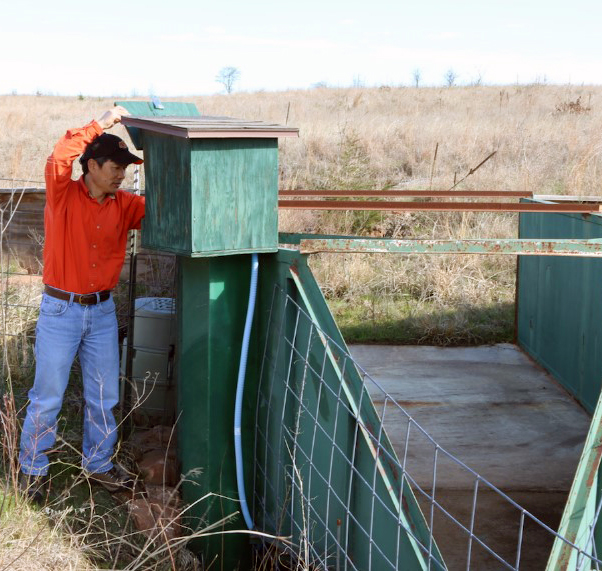
Studying Effects of Eastern Redcedar Encroachment on Surface Water Runoff
Small watersheds, also called micro-catchments, are widely used in studying water budgets associated with a given land use type or land cover type. This approach is valuable in quantifying the impact of  eastern redcedar encroachment on surface runoff from the tallgrass prairie. This has important implications, because if eastern redcedar uses more water than does tallgrass prairie vegetation, then less is available for streamflow, which is important for ecological and human uses.
eastern redcedar encroachment on surface runoff from the tallgrass prairie. This has important implications, because if eastern redcedar uses more water than does tallgrass prairie vegetation, then less is available for streamflow, which is important for ecological and human uses.
Several micro-catchments built in grasslands and loblolly pine plantations already exist at various locations in Oklahoma that were funded from various research projects and sources. Through the Oklahoma NSF EPSCoR project “Adapting Socio-Ecological Systems to Increased Climate Variability,” funding allowed construction of three new micro-catchments in the oak forests at the Oklahoma State University’s Range Research Station. Additionally, aging instruments at existing micro-catchments were upgraded in both the grasslands and loblolly pine forests.
EPSCoR researcher Dr. Chris Zou uses the micro-catchments to conduct studies, which can be used to understand climate and land-use impacts on water quantity and quality.
“The impact of land management on ecosystem services such as streamflow and groundwater recharge can be quantified by micro-catchment studies,” Zou said.
 Hence, Dr. Zou, OSU’s Ecohydrologist from the Department of Natural Resource Ecology and Management (NREM), collaborated with NREM colleagues, Drs. Donald Turton, Rodney Will, Lei Qiao and Elaine Stebler, to study how eastern redcedar encroachment affects the annual runoff depth and runoff generation mechanisms in the tallgrass prairie.
Hence, Dr. Zou, OSU’s Ecohydrologist from the Department of Natural Resource Ecology and Management (NREM), collaborated with NREM colleagues, Drs. Donald Turton, Rodney Will, Lei Qiao and Elaine Stebler, to study how eastern redcedar encroachment affects the annual runoff depth and runoff generation mechanisms in the tallgrass prairie.
“Eastern redcedar encroachment into grasslands is a major issue in Oklahoma as it can impact streamflow and water supply,” Zou said.
The research team built seven experimental watersheds, three of which are on grassland sites and four on adjacent sites that were heavily encroached by eastern redcedar.
“Our results showed that less than 2 percent of annual precipitation became runoff in watersheds encroached with eastern redcedar, which was significantly lower than about 5 percent from grassland watersheds for the four years of our study,” Qiao said. “We also found that eastern redcedar encroachment resulted in the reduction of both surface and sub-surface flows and the magnitude of reduction depended on annual rainfall."
The reduction in runoff from eastern redcedar watersheds was associated with shifts in runoff mechanisms. “Eight-seven percent of the total runoff from grassland watersheds occurred under saturated or nearly saturated soil condition while 86 percent of runoff from eastern redcedar encroached watersheds occurred under unsaturated soil condition, which suggests a shift from saturation excess runoff to infiltration excess runoff,” Qiao said.
“On average, the annual runoff depth was 22 mm less in watersheds with eastern redcedar than grassland watersheds over the study period, which accounts for the three percent runoff coefficient reduction when compared to grasslands,” Qiao added.
“Our soil moisture data indicated that the soil profile under eastern redcedar rarely became saturated and did not stay above field capacity very long even after a heavy rainfall,” Stebler said.
“Our results provide insights in predicting changes in water resources under vegetation changes,” Will said. “To sustain our water resources in the Southern Great Plains, watershed managers should use best management practices to control or prevent woody plant encroachment into the grassland,” Zou said.
Funding for this project was provided by National Science Foundation grant DEB-1413900 and grant OIA-1301789 through OK NSF EPSCoR, USGS (G12AC00002), USDA-NIFA (2014-67010-21653), and the Oklahoma Agricultural Experiment Station.
Pictured (top) Dr. Zou at a grassland site micro-catchment; (bottom) chart illustrating interaction of runoff, antecedent soil water storage, rainfall, and vegetation type.
___________
Story Written by Dr. Pamela Abit, Oklahoma NSF EPSCoR Program Coordinator. For more information about the research highlighted in this article, contact Dr. Chris Zou at [email protected].
